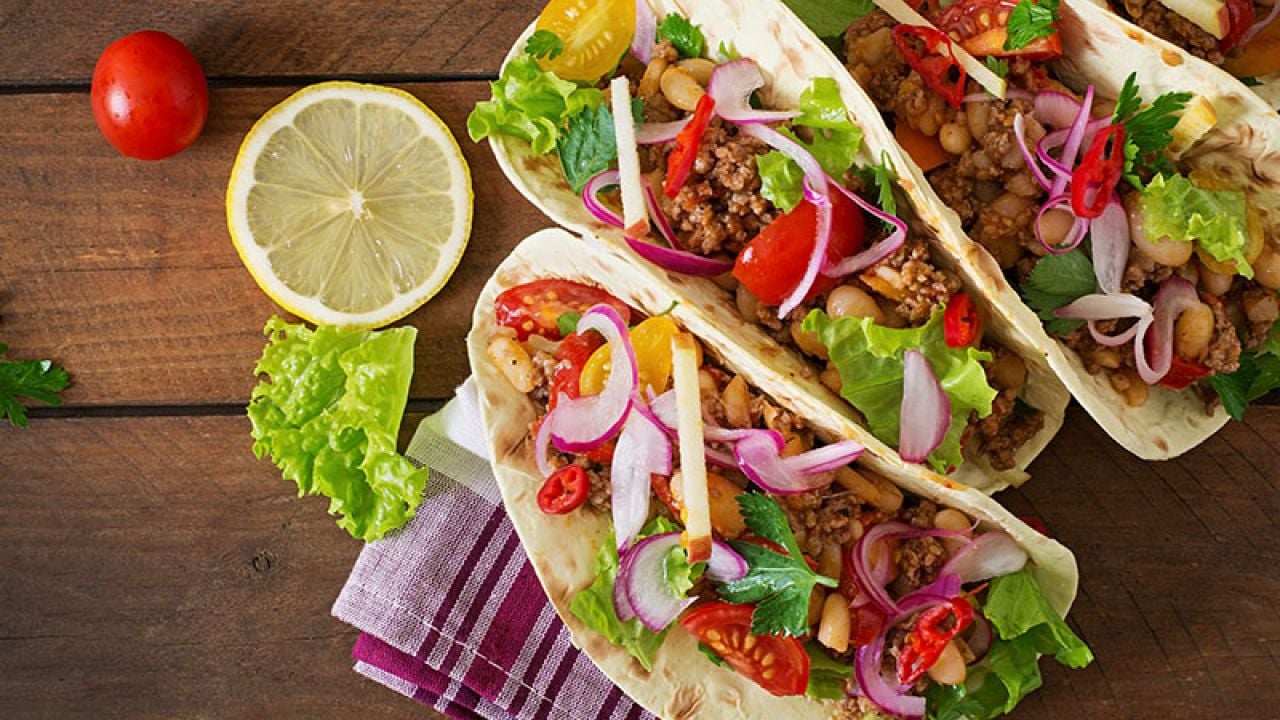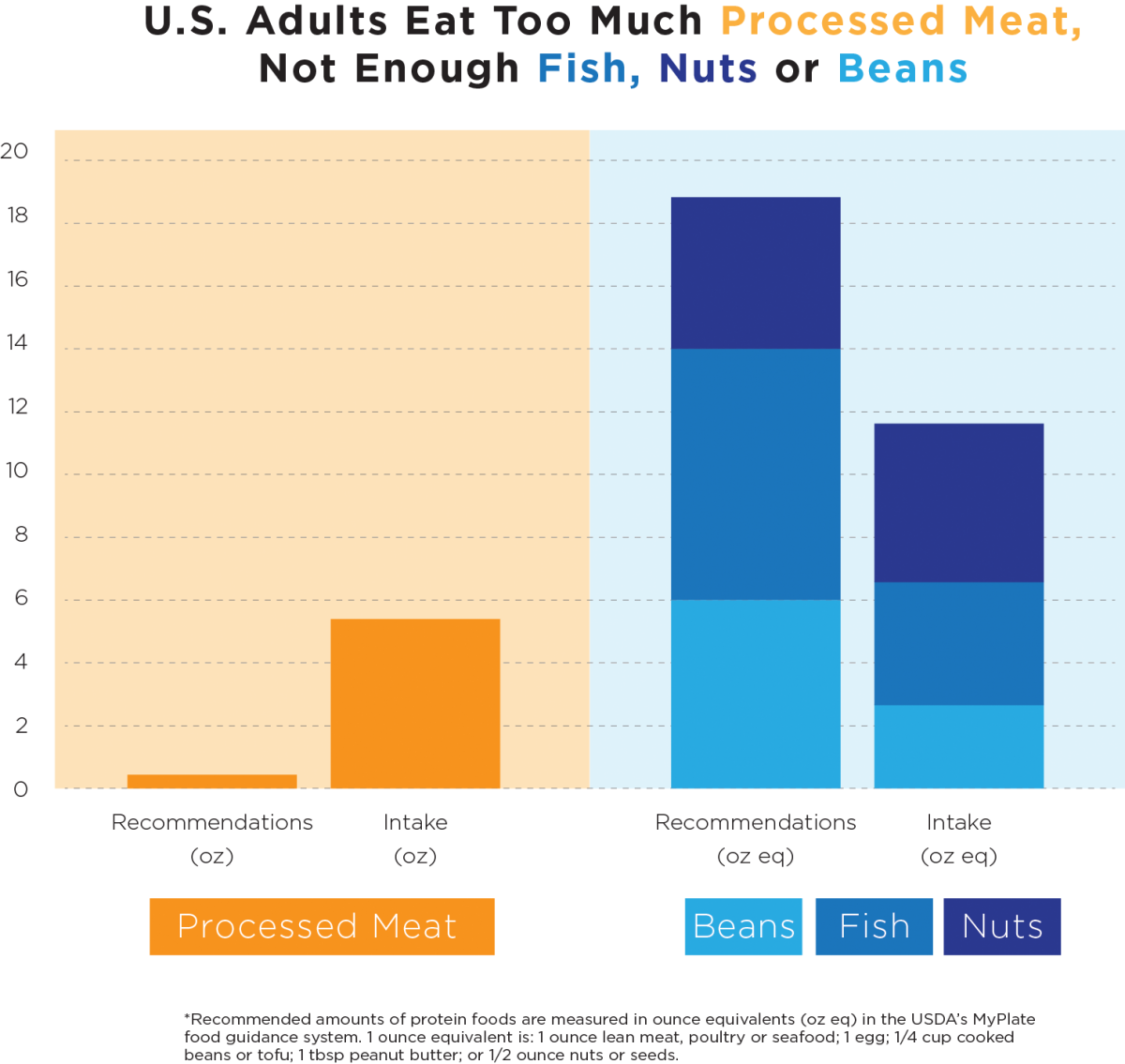
When health experts look back on the diets of current generations, obsession with protein will surely rank high as a mistake.
Here’s the hard truth: Americans eat more protein than they need – specifically, too much animal protein – averaging a small hamburger’s worth, or 2 ounces, of excess per week.1,2
Even the U.S. Department of Agriculture’s notoriously industry-friendly MyPlate nutrition guidelines state, “most Americans eat enough [protein] … but need to make leaner and more varied selections.”3 The guidelines note that “teen boys and adult men, also need to reduce overall intake of protein foods by decreasing intakes of meats, poultry and eggs and increasing amounts of vegetables or other underconsumed food groups.”4
For most people that means eating fewer processed meats and more low-mercury seafood, beans, nuts and seeds.
While our appetite for red meat has decreased, Americans still eat far too much processed meat5 – foods like hot dogs, cold cuts, sausages and bacon. The World Health Organization determined these foods cause cancer in humans.6 The equivalent of one hot dog every day increases the risk of colon cancer – the second deadliest cancer in the U.S.7 – by 18 percent.
But beyond processed and red meat, it’s safe to say that most Americans are unaware that too much protein itself can be damaging to health.
Too much protein is hard on:
- Your kidneys. This chronic stress can lead to severe kidney damage.8,9
- Your bones. As the kidneys age, they are less able to handle the acid produced by the metabolism of a high protein diet, which can affect bone health. A high ratio of animal to vegetable protein has been linked to hip fracture risk.10
- Our planet. A 2011 EWG analysis found that each burger we eat has a climate impact similar to driving a car 6 1/2 miles. To produce meat, farmers use large amounts of pesticides, chemical fertilizers, fuel, feed and water, generating greenhouse gases, manure and other pollutants – which contaminate our air and water – in the process.
At the same time, Americans don’t eat enough seafood or plant proteins like beans, legumes or nuts.

Sources:
- Carrie R. Daniel et al., Trends in Meat Consumption in the United States. Public Health Nutrition, 2011; 14(4):575-583.
- World Cancer Research Fund/American Institute for Cancer Research. Food, Nutrition, Physical Activity, and the Prevention of Cancer: A Global Perspective. Washington, D.C. Available at http://wcrf.org/sites/default/files/Second-Expert-Report.pdf
- Dietary Guidelines for Americans 2015. Available at http://health.gov/dietaryguidelines/2015/guidelines/appendix-3/
- U.S. Department of Agriculture, All About the Protein Foods Group. ChooseMyPlate.gov, 2016. Available at http://www.choosemyplate.gov/protein-foods
- Biing-Hwan Lin et al., U.S. Food Commodity Consumption Broken Down by Demographics, 1994-2008, ERR-206. U.S. Department of Agriculture, Economic Research Service, March 2016.
- Patricia M. Guenther et al., Most Americans Eat Much Less than Recommended Amounts of Fruits and Vegetables. Journal of the American Dietetic Association, 2006; 106:1371-1379.
It’s clear that protein variety matters for protection against cancer, heart disease and diabetes. The 2015 to 2020 Dietary Guidelines for Americans made the recommendation “to increase variety in protein food choices.” On top of that, a 2006 study from the University of Krakow in Poland found that avoiding certain foods was less important for reducing cancer risk than maintaining a balanced diet, which was best evaluated by the ratio of vegetables to meat participants ate.11 A study by scientists at the National Cancer Institute found that substituting a serving of red meat for another protein choice could reduce the risk of some cancers.12
Eating eight ounces of low-mercury seafood a week – about two servings – and more beans is an easy way to consume a healthy variety of protein sources. Beans are powerhouses. They can help protect us against heart disease13 and diabetes,14 and they contain fiber to help prevent colon cancer.15 They also contain beneficial vitamins like folate, minerals like iron and potassium, and potential cancer-fighting phytochemicals like saponins and oligosaccharides.16
One recent study found that beans kept men ages 18 to 40 feeling satisfied longer. After they ate beans, the men ate 12 to 13 percent fewer calories than they did after a high protein meal of meat.17 It’s a win-win.
How to get started
Luckily, there are a lot of easy swaps and unexplored protein options to supplement previously meat-focused diets.
- Choose a fish sandwich over a BLT to swap processed meat for seafood.
- Choose chili with beans over chili with meat to swap red meat for beans.
- Choose taco salad topped with edamame or black beans, instead of grilled chicken, to swap animal protein for plant protein.
- Choose lentil soup over chicken noodle soup to swap animal protein for the plant protein with lowest carbon footprint.
- Follow Meatless Mondays on Instagram for inspiration.
References
1 Carrie R. Daniel et al., Trends in Meat Consumption in the United States. Public Health Nutrition, 2011; 14(4):575-583.
2 Dietary Guidelines for Americans 2015. Available at health.gov/dietaryguidelines/2015/guidelines/appendix-3/
3 U.S. Department of Agriculture, All About the Protein Foods Group. ChooseMyPlate.gov, 2016. Available at www.choosemyplate.gov/protein-foods
4 U.S. Department of Health and Human Services and U.S. Department of Agriculture, Dietary Guidelines for Americans 2015. Office of Disease Prevention and Health Promotion, 2015. Available at health.gov/dietaryguidelines/2015/guidelines
5 Carrie R. Daniel et al., Trends in Meat Consumption in the United States. Public Health Nutrition, 2011; 14(4):575-583.
6 Veronique Bouvard et al., Carcinogenicity of Consumption of Red and Processed Meat. The Lancet Oncology, 2015; 16(16):1599-1600.
7 National Cancer Institute, Common Cancer Types. 2016. Available at www.cancer.gov/types/common-cancers
8 Quan-Lan J. Lew et al., Red Meat Intake and Risk of ESRD. Journal of American Society of Nephrology, 2017; 28(1):304-312.
9 National Kidney Foundation, Dialysis. 2015. Available at www.kidney.org/atoz/content/dialysisinfo
10 Deborah E. Sellmeyer et al., A High Ratio of Dietary Animal to Vegetable Protein Increases the Rate of Bone Loss and the Risk of Fracture in Postmenopausal Women. American Journal of Clinical Nutrition, 2001; 73:118-122.
11 Maria Kapiszewska, A Vegetable to Meat Consumption Ratio as a Relevant Factor Determining Cancer Preventive Diet: The Mediterranean Versus Other European Countries. Forum Nutrition, 2006; 59:130-153.
12 Carrie R. Daniel et al., Prospective Investigation of Poultry and Fish Intake in Relation to Cancer Risk. Cancer Prevention Research, 2011; 4(11):1903-1911.
13 Lydia A. Bazzano et al., Legume Consumption and Risk of Coronary Heart Disease in US Men and Women: NHANES I Epidemiologic Follow-Up Study. Archives of Internal Medicine, 2001; 161:2573-2578.
14 Andrea M. Hutchins et al., Phaseolus Beans: Impact on Glycaemic Response and Chronic Disease Risk in Human Subjects. British Journal of Nutrition, 2012; 108:S52-65.
15 John C. Mathers, Pulses and Carcinogenesis: Potential for the Prevention of Colon, Breast and Other Cancers. British Journal of Nutrition, 2002; 88:S273-S279.
16 Diane C. Mitchell, Consumption of Dry Beans, Peas, and Lentils Could Improve Diet Quality in the US Population. Journal of the American Dietetic Association, 2009; 109:909-913.
17 Marlene D. Kristensen et al., Meals Based on Vegetable Protein Sources (Beans And Peas) are More Satiating than Meals Based on Animal Protein Sources (Veal And Pork) a Randomized Cross-Over Meal Test Study. Food & Nutrition Research, 2016; 60:32634.